#Masturus lanceolatus
Text
Wet Beast Wednesday: ocean sunfish
Everybody knows ocean sunfish, right? Those giant, slow, silly-looking, parasite-ridden morons that eat jellyfish and can't defend themselves from predators really are the worst fish right?

(GIF: Lex Luthor screaming "WRONG!" from the movie Superman Returns)
First of all there's no such thing as a "best" or "worst" animal and judging animals by human standards of what is cool or successful is silly because our standards are not even universal among humans, let along other species. Secondly, the closest thing we have to a way to judge a species is how successful it is in its niche and sunfish are doing pretty good, thank you very much. Today I'll be talking about sunfish and how they are not bad fish at all.
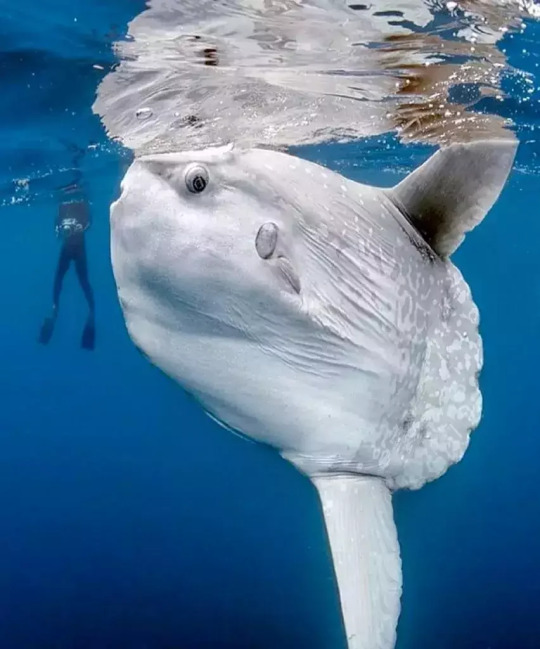
(Image: a Mola mola located near the surface of the ocean, with the tip of its dorsal fin and part of its head breaching the surface. It is a round fish with no tail, only a wrinkly region of its body. Its dorsal and anal fins are long and slender The eyes and mouth are proportionately small. It is a pale white with light grey spots. A SCUBA diver is visible in the background. End ID)
Ocean sunfish, or molas, are members of the family Molidae, which is divided into five known species across three genuses. Im mostly going to be talking about members of the genus Mola, but I'll mention the other two as well. Molas are known for their size and odd appearances, looking like someone chopped a fish in half and the front half went swimming off on its own. They are members of the order Tetraodontiformes, making them cousins to pufferfish, triggerfish, boxfish, and others. While many members of that order are known to be highly poisonous, molas are not. They also lack several other common traits. Despite being bony fish, most of the mola skeleton is made of cartilage and they do not have swim bladders, forcing them to actively swim to maintain their position in the water column. Instead of a tail and caudal fin, sunfish have a structure called the clavus. The clavus is formed mostly from connective tissue and is used as a rudder. Because the clavus is mostly made of connective tissue, damage to it is not particularly harmful to the fish. There have been molas found alive and well that have had portions of their clavus eaten by predators. Because of their shortened stature, molas have the fewest vertebrae of all fish. The dorsal and anal fins are elongated and are used to provide propulsion by flapping back and fourth similarly to how birds wings move, albeit slower. Minute alterations in the angle each fin moves through the water help with steering, while more sharp turns are aided with jets of water ejected through the mouth and gills. Like their other Tetraodintid relatives, mola teeth are fused together into a beak-like structure that prevents them from closing their mouths. They also have some more regular pharyngeal teeth in the backs of their mouths. Some reports say that the fish can make noises by grinding the pharyngeal teeth together. Mola skin is thick and rough, described as being similar to sandpaper in texture. Like most fish, the skin is covered in a layer of protective mucus.

(Image: a mola sunbathing. It is positioned with one side of its body facing the surface. Its body is just under the water's surface. End ID)
The three species in the genus Mola are Mola mola, the ocean sunfish and most well-known of the molas, Mola alexandrini, the giant, southern, or bumphead mola, and Mola tecta, the hoodwinker sunfish. Mola mola has an average weight of 247 to 1000 kg (545 to 2205 lbs), mouth to clavus length of 1.8 m (5.9 ft) and dorsal to anal fin length of 2.5 m (8.2 ft), though some individuals can get much large. The largest individual on record had a length of 3.3 m (10.8 ft), height of 3.2 m (10.5 ft) and weighed 2300 kg (5100 lbs). M. alexandrini is the largest of the species. The largest known southern sunfish measured in at 2744 kg (6049 lbs) and 3.25 m (10.66 ft) from mouth to clavus, making it the largest known bony fish in the world. They can be distinguished from M. mola by the presence of bumps on the forehead and chin, a more rounded clavus, and differently-shaped scales. M. tecta is known as the hoodwinker sunfish because it was long mistaken for one of the other two species and was only identified as a separate species in 2015 after the body of one washed up in Christchurch, Aotearoa/New Zealand and was examined by scientists. Because it has only recently been discovered, little is known about this species. They appear to have the same range of sizes and weights of the other two species and can be distinguished by a slimmer body shape and a smooth clavus. All three species are found in tropical and temperate waters worldwide, though M. alexandrini and M. tecta are more commonly found in the southern hemisphere.
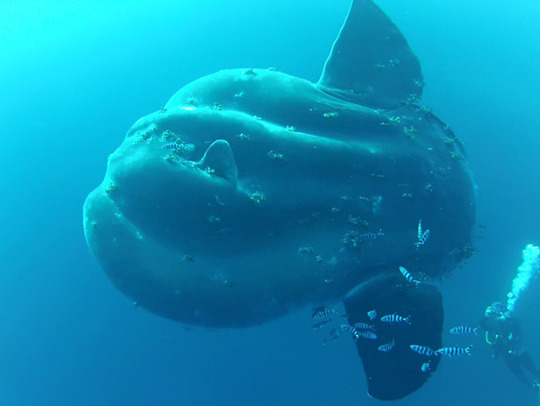
(Image: a Mola alexandrini underwater. It is distinguishable from Mola mola by the two bumps above and below its facial region, making it look lumpy. It is surrounded by striped cleaner fish. A SCUBA diver is in the background. End ID)
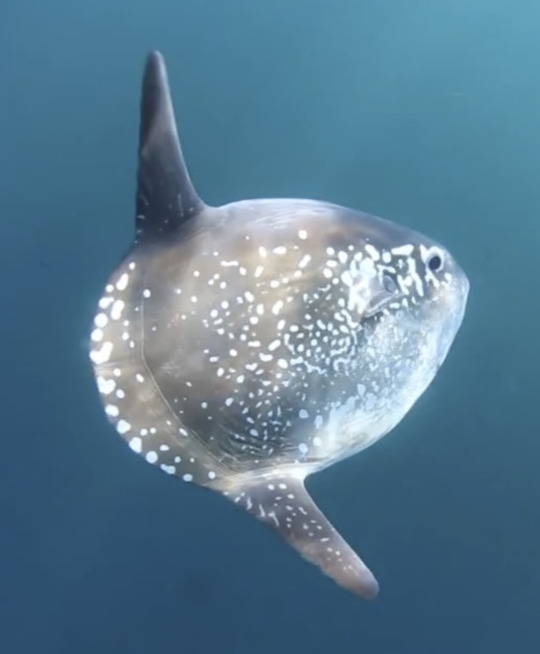
(Image: a Mola tecta seen from the side. It is smoother than the other two species. More of its body is grey with white spots. End ID)
Molas are open-ocean dwellers that live life in the slow lane. For a long time, it was believed they were moved around by ocean currents they could not swim against, making them plankton. We now know they not only can swim against the current, they are capable of bursts of speed fast enough to breach the water's surface and briefly go airborne. Sunfish are named for their habit of basking at the surface of the water. It was formerly believed they spent most of their time at the surface, but thanks to tagging, we know they make frequent dives into the deep ocean. They likely bask at the surface to warm up between dives. You may not expect something as slow as a sunfish to be a predator, but they are. Much of their diet consists of gelatinous animals including jellyfish, siphonophores, ctenophores, and salps, though they will also eat small fish, fish larvae, squids, crustaceans, and even seagrass. Because they can't chew, sunfish move prey into and out of their mouth by rapidly switching between sucking water in and spitting it out in order to shred the prey into pieces small enough to swallow. Special mucus lining the digestive system may protect the molas from the stinging tentacles of their prey. Molas and other jellyfish-eaters like the leatherback sea turtle play an important role in the ecosystem by keeping jellyfish populations down. Jellyfish are not particularly nutritious, so the sunfish need to eat a lot of them to survive, something they seem to be pretty good at. Being slow and having a very low-energy lifestyle helps the fish survive on a less-nutritious diet, making them very energy efficient. One thing molas get a lot of flack for online is having lots of parasites (with up to 40 known species). This doesn't really make sense. Every species has parasites. An animal in the wild that doesn't have parasites is vanishingly rare. Having parasites doesn't make an animal suck, it makes them ordinary. Because of their parasite load, molas are frequent visitors to cleaner fish, who will eat their parasites. Molas will also let seabirds land on them and eat their parasites while they rest on the surface. The molas attract birds by splashing at the surface. Adult molas have few natural predators, but are hunted by sharks, sea lions, and orcas. Interestingly, sea lions have been known to kill molas apparently for sport, ripping off the fins and then leaving the mola to die.

(Image: a mola seen from the front. Multiple smaller fish are picking parasites off of its skin. End ID)
Molas are broadcast spawners who release their gametes into the water alongside each other. A female mola can release 300 million eggs at a time, more than any other vertebrate. Newly hatched sunfish are 2.5 millimeters long and are often cited as having the largest discrepancy in size between juvenile and adult of any vertebrate. An adult mola can be 60 millions times the weight of a larva. The larvae look very different than adult, lacking their dorsal and anal fins but having pufferfish-like spines. Juveniles school together for protection and become solitary as they age. The diet of the fish varies as they age, with younger fish feeding more on squid, worms, crustaceans, and fish but becoming more reliant on jellyfish and other gelatinous prey as they age. We don't know the growth rate of molas, but a juvenile in the Monterey Bay Aquarium grew from 26 to 339 kg (57 to 880 lbs) in 15 months, suggesting they grow rapidly. The maximum age of molas is unknown, though individuals in captivity have lives for up to 10 years.

(Image: a mola larva. It is a brown ball with large, black eyes and no visible fins. It is covered in transparent, conical spines. End ID)
The two non-Mola sunfish are Ranzania laevis, the slender sunfish and Masturus lanceolatus, the sharptail sunfish. Both are alone in the genuses, but other species are suspected. I also found references to other species in Masturus, but could find literally no information about them other than that Masturus oxyuropterus is listed in some records. The sharptail sunfish looks very similar to Mola mola and reaches similar sizes, but its clavus has an extension that looks like a short tail. They were initially believed to be deformed molas before being recognized as a separate species. Unlike molas, sharptail sunfish are rarely seen at the surface, preferring to stay in deeper water. The slender sunfish is the smallest of the family, reaching up to a meter long. While we don't know much about them, we know their diet includes a lot of fast-moving squid, indicating they can move faster than their much larger relatives.
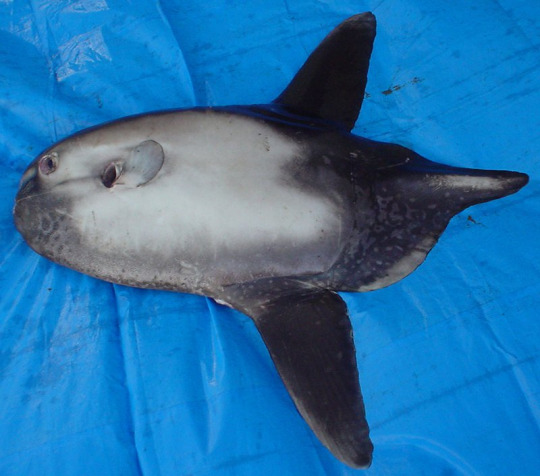
(Image: a sharptail sunfish lying on a blue tarp. It looks similar to a Mola mola , but with black clavus and fins. At the back of the clavus is a triangular extension. End ID)
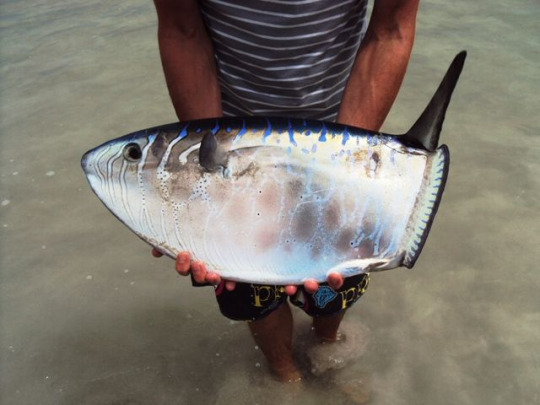
(Image: a person holding a slender sunfish. The fish is small enough to be held and has a longer and skinnier body than other sunfish. Its body is a shiny silver with blue lines. End ID)
Mola mola is classified as vulnerable by the IUCN while the other species are classed as either data deficient or least concern. Molas are vulnerable to strikes by boats and bycatch. Another danger to them is plastic bags, which can easily be ingested after being mistaken for a jellyfish. The bags can suffocate the fish or block their digestive tracts. Despite their size, molas are docile and not dangerous to humans. I found one example of a mola harming a human and it happened when the fish jumped out of the water and landed on a boat. Allegedly, some fish have learned to recognize and approach SCUBA divers. Molas are difficult to keep in captivity due to their size, the amount of space the need, and special feeding needs, so only a few aquariums have them. Molas are captured for food, with the biggest markets being in Taiwan and Japan, where they are often called mambos.
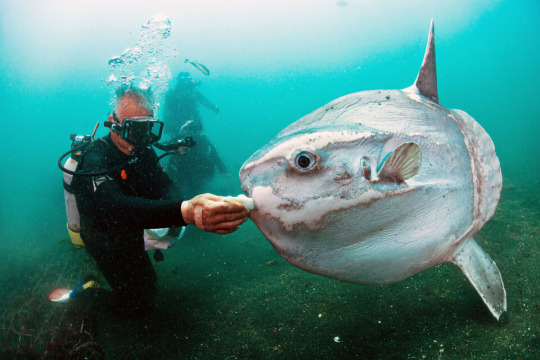
(Image: a SCUBA diver attempting to hand feed a small mola. End ID)
#wet beast wednesday#ocean sunfish#mola mola#name so nice you say it twice#countering sunfish slander#mola alexandrini#mola tecta#sharptail mola#Masturus lanceolatus#slender sunfish#Ranzania laevis#fish#fishblr#fishposting#marine biology#biology#zoology#ecology#animal facts#image described
177 notes
·
View notes
Text


Rejoice, dear followers! Our congregation has grown! We welcome our fellow siblings to the shoal, our hearts sing as they accept the loving holy light that gleams off the Great Ocean Sunfish.
As we open our hearts, we open our inbox. Speak, my children! Sing words of praise and adoration!
Mola tecta! Masturus lanceolatus! Mola alexandrini! Mola mola! All hail the ocean sunfish 🙏🙏🙏
#ocean sunfish#mola mola#digital art#stained glass#marine life#illustration#all hail the ocean sunfish 🙏🙏🙏
94 notes
·
View notes
Note
If you were a fishie what kind would you be
A ginormous one
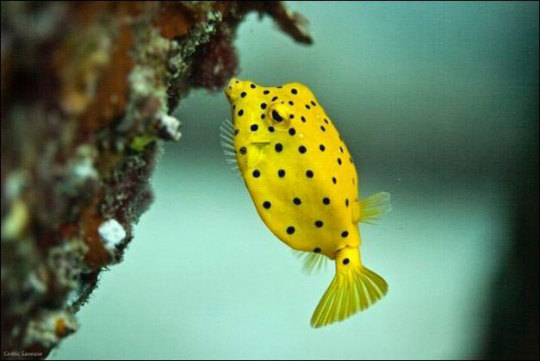
Probably a box fish or some other kind of Tetradontiforme fishie.

Perhaps a juvenile Masturus lanceolatus because OUGH they are fuckijn ORB
8 notes
·
View notes
Text
First Record of the Ocean Sunfish, Mola alexandrini (Ranzani 1839), (Tetraodontiformes: Molidae) from the Coastal Waters of Andhra Pradesh, India

Authored by: P Padmavathi
Abstract
Mola alexandrine, commonly known as bump-head sunfish has been reported for the first time from Andhra Pradesh coastal waters. A detailed morphological description of the specimen is provided, and the morphometric and meristic data are compared with those of the same species reported by earlier workers. Historical records of the family Molidae from Indian waters are summarized and discussed.
Keywords: First record; Mola alexandrine; Morphometrics and meristics; Ocean sunfish
Introduction
The ocean sunfishes belonging to the family Molidae are composed of three genera (Ranzania, Masturus and Mola) with five valid species viz., Ranzania laevis (Pennant 1776), Masturus lanceolatus (Lienard 1840), Mola mola (Linnaeus 1758), Mola tecta (Nyegaard et al. 2017) and Mola alexandrini (Ranzani 1839) [1-4]. Family Molidae is monophyletic among highly derived order Tetraodontiformes [5] and characterized by distinctly-shaped body by the lack of true caudal fin, which is replaced by a broad stiff lobe, a pseudo-caudal fin called clavus [6]. These fishes are known to be active swimmers and opportunistic foragers in the pelagic waters of both temperate and tropical oceans [7-9]. The occurrence of ocean sunfishes is rare from Indian coastal waters [10]. However, the presence of some molds has been reported in new areas [11] and previously known distribution ranges are being expanded [12]. These fishes occupy a unique position in marine food web [13,14]. The consumption of these oddly species has not been attracted the folk’s attention due to their rare occurrence and lack of information on their nutritional aspects. However, the meat of the ocean sunfishes is reported to be delicious in Taiwan and Japan [15].
The bump-head sunfish, Mola alexandrini (Ranzani 1839) is a large pelagic species which claimed a record of world’s heaviest teleost fish with a weight of 2,300 kg with 272 cm TL [16]. However, this fish may grow even larger [17]. Sawai et al. [16] found Mola alexandrini (Ranzani 1839) to be synonymous with Mola ramsayi (Giglioli 1883). The present study reports the first record of M. alexandrini from the coastal waters of Andhra Pradesh, India, and an attempt was made to compare the morphological, morphometric, and meristic characters among the known records of the species. The historical records of the family Molidae from the Indian coastal waters are provided and discussed.
Materials and Methods
One specimen of M. alexandrini was collected as by-catch from trawl catches of Kakinada fishing harbor (16° 58′ 30″ N, 82° 16′ 44″ E), East Godavari district, Andhra Pradesh, India (Figure 1). The fish was caught from commercial trawler operated at a depth range of 20-100m on 11th December 2018. The morphological characters were observed in fresh specimen. Morphometric and meristic details were recorded using the standard methods of Fraser-Brunner [6] and Whitley [18]. The species was identified based on the description given by Fraser-Brunner [6]; Sawai et al. [16]; Yosita et al. [17]; Nyegaard et al. [19]. Morphometric measurements were taken as straight-line distances (±1mm) using a 500 cm tape with 1mm gradation.
They included the total length (TL), a linear distance from the tip of the snout to the distal edge of the clavus; pre-clavus band length (PCBL), the straight distance from the tip of snout to the origin of clavus; total body depth (TBD), a linear length between dorsal fin and anal fin tips; body depth (BD), vertical distance between the dorsal and ventral margin of the body where the height is greatest; eye diameter (ED), the distance between the anterior and posterior edges of the orbit; pre-orbital length (POL), the distance between the tip of snout to the origin of eye orbit; pre-dorsal length (PDL), a straight distance from the tip of the snout to the anterior edge of dorsal fin; pre-pectoral length (PPCL), measured from the tip of snout to the anterior end of the pectoral fin; pre-anal length (PAL), a straight distance from the tip of the snout to the anterior end of the anal fin; height of dorsal fin (DFH), the vertical distance from the base to the tip of the dorsal fin; height of anal fin (AFH), the vertical distance from the base to the tip of the anal fin; and length of pectoral fin (PCFL), measured between its origin to the extreme tip. Meristic characteristics included the counts of fin rays in dorsal, pectoral, and anal fins, and clavus ossicles.
Results
Taxonomic position
• Phylum: Chordata
• Class: Actinopterygii
• Order: Tetraodontiformes Berg, 1940
• Family: Molidae Bonaparte, 1835
• Genus: Mola Koelreuter, 1766
• Species: M. alexandrini (Ranzani 1839).
Description
Body orbicular, deep and laterally compressed; skin thick and leathery; scales rectangular; mouth small and terminal; teeth on both jaws fused and beak-like; eyes small; pair of small nostrils in front of eyes; head bump extends from above the eyes to the base of dorsal fin; chin bump from beneath the lower jaw to anal fin base; gill openings small and oval; dorsal and anal fins opposite and triangle shaped; fins with soft rays and spineless; pelvic and caudal fins absent; caudal fin replaced by broad clavus with round margin; smooth band at the base of clavus between dorsal and anal fins; pectoral fin small rounded. Body gray to silvery white dorsally, dusky white ventrally, dorsal and clavus region with reddish brown tinge; fins bluish black, and many irregular paler spots over the body (Figures 2 & 3). The morphometric and meristic characters of the present specimen along with those of earlier works on M. alexandrini are shown in Table 1.
Discussion
The homogeneity in the morphological characters of Mola has created confusion in the species identification. However, the major distinguishing characters for the identification of Mola species are the presence or absence of head bump, chin bump and smooth band back-fold at the base of clavus; shape of the clavus margin; number of fin rays and ossicles in clavus; and the shape of the body scales [6,16,17,19-22]. The diagnostic characters of M. alexandrini observed in the present study such as the presence of head and chin bumps; smooth band at the base of clavus without a back-fold; rounded clavus; 12 clavus ossicles; scales rectangular on middle region of body and paler spots over the body are in conformity with those observed by the earlier workers [6,16,19].
The historical records of the family Molidae for over 65 years (1953-2018) from Indian coastal waters have been presented in Table 2. Based on the historical data, the distribution of the family Molidae in Indian waters is restricted to four species namely M. mola, M. lanceolatus, R. laveis, and M. alexandrini. Of these, M. mola [23] and M. lanceolatus [24] have been reported from coastal waters of Andhra Pradesh. M. alexandrini was reported in Indian waters with the rare occurrence of two records, one from Chennai, Tamil Nadu by Mohan et al. [21] and the other from Kochi, Kerala by Kishor et al. [20]. Hence, it is evident that the current reporting of M. alexandrini is the 3rd record from India and the first ever report from Andhra Pradesh.
In Indian coastal waters, the ocean sunfishes are considered as vagrant species, with only few sporadic sightings. Since 1990’s, however, there has been a considerable increase in the frequency of molids observed in Indian waters [25-30] (Table 2). The occurrence of M. alexandrini in the study area might be due to the fact that the species which are weak may get drifted to the coastal waters by strong currents or in course of chasing specific plankton/diatoms, as they are opportunistic foragers and selective feeders [3,5,13]. Moreover, in recent times there has been a massive development of fisheries and upgraded fishing vessels extended their trawling operations into deeper waters, catching more varieties of fishes in the study region [31-35]. The present report of the species from Andhra Pradesh coastal waters along central east coast of India would help in creating new awareness and scope for the proper documentation of data on this deficient species from the Indian waters [36-47].
N- Number of individuals; TL- Total length; TW- Total weight
To Know More About Oceanography & Fisheries Open Access Journal Please click on:
https://juniperpublishers.com/ofoaj/index.php
For more Open Access Journals in Juniper Publishers please click on:
https://juniperpublishers.com/index.php
0 notes
Text
An ASCII overview of the Molidae fish family:
Common sunfish
Mola mola
|\
Σ  ̄ ̄\
Σ C ° 3
Σ ____/
|/
Bumphead sunfish
Mola alexandrini
|\
Σ  ̄ ̄)
Σ C ° 3
Σ ___/
|/
Hoodwinker sunfish
Mola tecta
|\
Σ || ̄ ̄\
Σ= C ° 3
Σ ||____/
|/
Sharptail sunfish
Masturus lanceolatus
|\
Σ  ̄ ̄\
< C ° 3
Σ ____/
|/
Slender sunfish
Ranzania laevis
|\_______
( •o•
|/ ̄ ̄ ̄
#monterey bay aquarium#mola#molidae#mola mola#mola tecta#mola alexandrini#masturus lanceolatus#ranzania laevis#ocean sunfish#common sunfish#hoodwinker sunfish#bumphead sunfish#sharptail sunfish#slender sunfish#ascii me anything
10K notes
·
View notes
Photo
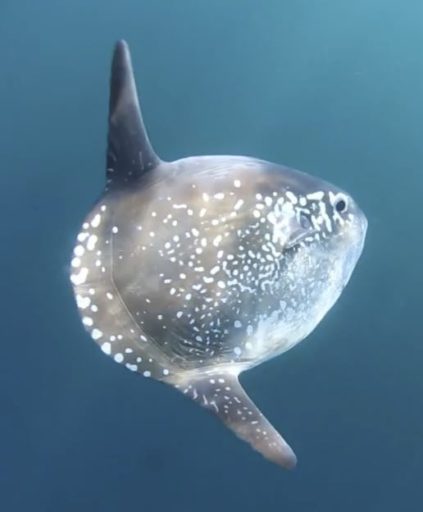
Tetraodontiformes: Molidae Meet the new giant sunfish that has evaded scientists for centuries
The massive ocean sunfish — an odd-looking fish with a flat, rigid, tailless body — is not only the world’s largest bony fish, but also one of the most elusive fishes in the world.
Now, for the first time in 130 years, scientists have identified and described a new species of this giant fish that they say has been “hiding in plain sight for centuries”. Lead author Marianne Nyegaard of the Murdoch University in Australia and her colleagues have named the new species the Hoodwinker sunfish or Mola tecta (derived from the Latin word tectus meaning disguised or hidden).
Spotting the sunfish is difficult because it lives a solitary life, diving hundreds of meters to feed and occurring in parts of the ocean where people don’t tend to go. The fish sometimes gets caught on fishing gear as bycatch or gets stranded on the beach, when it can be photographed or sampled.
As part of her PhD research, Nyegaard analyzed DNA from more than 150 skin samples of sunfish and found that the samples pointed towards four distinct species. But only three species — Masturus lanceolatus, Mola mola, and Mola ramsayi — had been previously described, the scientists report in a new study published in Zoological Journal of the Linnean Society. The fourth one had not been recorded yet. A Japanese research team had found similar genetic evidence of an unknown sunfish species in Australian waters some ten years ago.
To find out what this new species might look like, Nyegaard started scouring social media for pictures of sunfish and built a network of people across Australia and New Zealand who could alert her whenever a sunfish was observed. She hit the jackpot in 2014 when four sunfish were stranded on the same beach in New Zealand.
“I flew down to Christchurch, landed at night and drove out on to the beach,” Nyegaard wrote in the Conversation. “I saw my first hoodwinker sunfish in the headlights of the car – it was incredibly exciting. This changed everything, because now we knew what we were looking for.”
Over the next few years, Nyegaard and her colleagues from Hiroshima University, the University of Tokyo, the Museum of New Zealand Te Papa Tongarewa, and the University of Otago, collected and examined 27 specimens of the fish and reviewed old photos and museum collections to confirm and describe the new Hoodwinker sunfish.
“This new species is the first addition to the Mola genus in 130 years,” Nyegaard said in a statement. “The process we had to go through to confirm its new species status included consulting publications from as far back as the 1500s, some of which also included descriptions of mermen and fantastical sea monsters. We retraced the steps of early naturalists and taxonomists to understand how such a large fish could have evaded discovery all this time. Overall we felt science had been repeatedly tricked by this cheeky species, which is why we named it the Hoodwinker.”
The Hoodwinker sunfish can weigh up to two metric tonnes and can grow up to 2.5 meters (over eight feet), the team estimates. The fish’s slim, sleek body doesn’t change much between juveniles and adults and it doesn’t develop lumps and bumps during its growth like other sunfish species.
#Hoodwinker Sunfish#Mola tecta#Mola#Molidae#Tetraodontiformes#Acanthopterygii#Actinopterygii#Osteichthyes#fish#ocean#marine life#biodiversity
201 notes
·
View notes
Text
Nasa International Spaceport station To Be DEMOLISHED In Significant Fireworks Present.
Helping researchers successfully share their collaborate with wider audiences to advertise the extensive understanding of Earth as well as room science as well as its worth. If you loved this post and you wish to receive details relating to pexatherm.it i implore you to visit our own web-page. Welltory (iphone, Android) has also now shut its second investment round, raising $1 million from service angels. The first Kickstarter permitted us to produce a cutting-edge series of modular Battlezones terrain ceramic tiles. Alexandra grew up in Jamaica, where she played tennis skillfully as well as stood for Team Jamaica at the Federation Mug and Commonwealth Games.
These Earth-observing satellite possessions that we have are main to security to life, home and financial advancement and national safety and security," claims Busalacchi. In method, this normally takes the type of on the internet journals, to which scientists pay an in advance complimentary to cover modifying prices, which after that make sure the work is offered free to accessibility for anybody in perpetuity.
Beginning at about the 8 'clock placement, the cell divides making 2 different cells discovered in the mind. You will certainly likewise get a digital file of your unique production and recognition in the video game when it debuts. With this Kickstarter, we are expanding the variety with brand-new Industrial scenery, providing you a brand-new design of ceramic tiles to play with.
Colleges and kind structures are likewise adopting open licensing policies for the research study write-ups as well as data sets that their professors and also grantees create. Dengue high temperature collisions and also collects yourself the body immune system, to ensure that it is reset to eliminate tumor cells," says Bruce Lyday at PrimeVax. Yet the shoot 'em ups were less engaging to me compared to addressing the puzzles the game leaves existing about, or the fun/difficult platformer parts.
Before the management took office, researchers around the country downloaded government environmental data, fearing that it may be taken offline by the Trump administration. This is a luxurious walk degree for backers that are brand-new to ACKS and intend to capture up on every little thing they've missed. Nyegaard invested 4 years searching for the fish, after genetic sequencing of 150 samplings in her research study turned up with four different species: Masturus lanceolatus, Mola mola, Mola ramsayi, as well as a 4th which wasn't known about, she clarified in her post on The Discussion.
Science Kombat is a brand-new browser-based video game that lets a few of history's most popular researchers duke it out in an epic animosity match. We're partnering with MiniBloq to bring Drag-and-Drop configuring to Sparki! It is a new spacecraf just for backers, a brand new design. As a result, we once again endured the web traffic of the 101 to bring you all the companies providing on the secondly of Y Combinator's day of trials, for what is the 25th batch of startups that have undergone the program.
Hans' previous job experience spans venture capital, web start-ups, and tech investment financial over 18 years. Aid and check out innovative projects bring strong new ideas into the world with the Kickstarter app. Kickstarter pending, we will release this open BETA in late 2013/Early 2014. SpaceX stated: After a month-long stay at the International Space Station, Dragon will certainly go back to Planet on Monday, July 3 with greater than 4,000 extra pounds of cargo and also research study products for NASA.
The Initial draft Fiction as well as Non-Fiction Material Generator has actually been enhanced with much more expert system - all developed to generate topic-specific web content also much faster. The initial 100 backers will certainly get a one year membership (starting September) to the National Area Society, the preeminent citizen's voice on human spaceflight, exploration, negotiation & development.
The reality the study group located anything is unbelievable as the fragment was taking a trip at almost 670,616,629 miles per hour - and even at that speed just took care of to take a trip 2 millimeters before disappearing. This Write-up has an element height of 21. The sidebar dimension is long. The iceberg could be enough for one million individuals over 5 years.
Dr Laura Phipps of Alzheimer's Research study UK, said: There is installing proof of a web link between poor quality rest as well as Alzheimer's illness, yet it is challenging to tease apart domino effect in this partnership and identify whether rest problems could cause Alzheimer's mind adjustments or vice-versa. BRB leads as well as elderly team members have shown expertise in Personality Action genres with these notable ceramic tiles, collectively marketing over 50 million systems.
0 notes
Photo



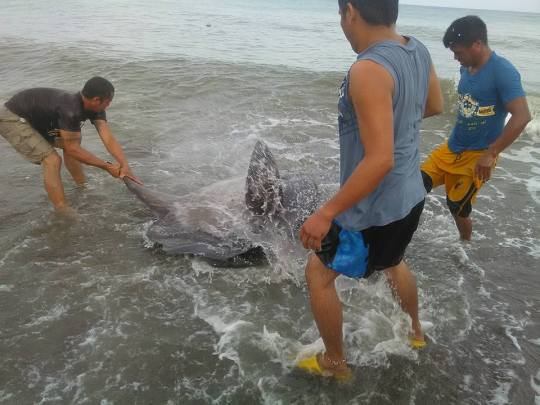
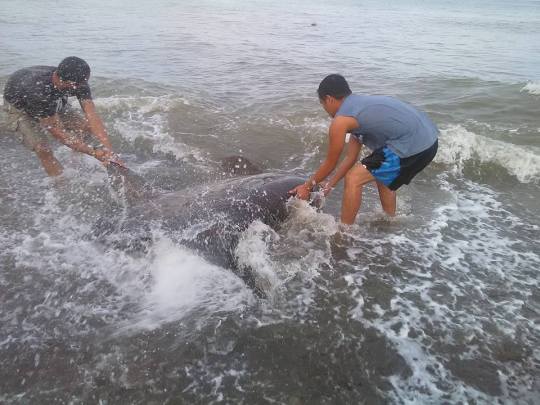
Another Ocean Sunfish found on the shores of Balabago, San Joaquin, Iloilo today.
Source: Ric Gaviloria Facebook, via Marine Wildlife Watch of the Philippines Facebook
This looks like it might be a Sharptail Mola (Masturus lanceolatus).
#sharptail mola#Masturus lanceolatus#sharptail sunfish#sunfish#sunfishes#ocean sunfishes#Molidae#Tetraodontiformes#fishes#teleosts#marine#Philippines#Iloilo#Panay#Western Visayas#Visayas#stranding#Marine Wildlife Watch of the Philippines
1 note
·
View note
Photo


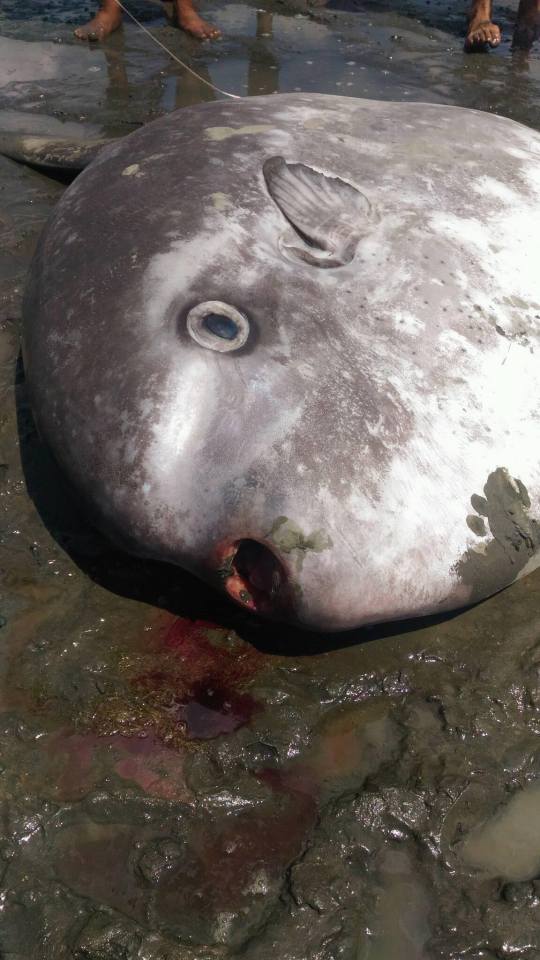
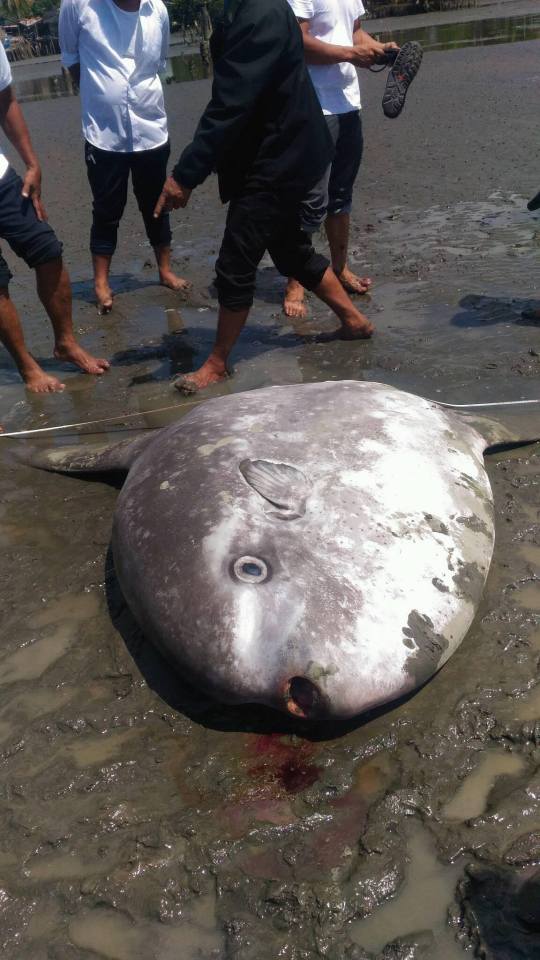
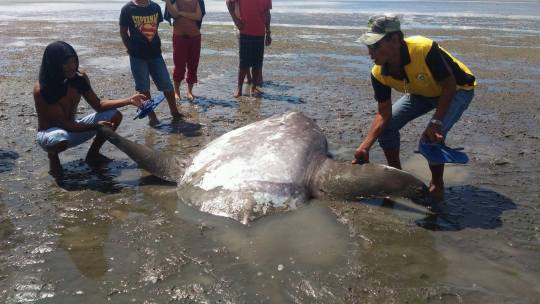

A Sharptail Mola (Masturus lanceolatus) found in the coastal area of Cagangohan, Panabo City, Davao del Norte today.
Source: Bfar-PFO Davao del Norte Facebook, via Marine Wildlife Watch of the Philippines Facebook
#sharptail mola#sharptail sunfish#Masturus lanceolatus#sunfish#sunfishes#ocean sunfishes#Molidae#Tetraodontiformes#marine#fishes#teleosts#Philippines#Mindanao#Davao del Norte#Davao#Panabo#Marine Wildlife Watch of the Philippines
11 notes
·
View notes